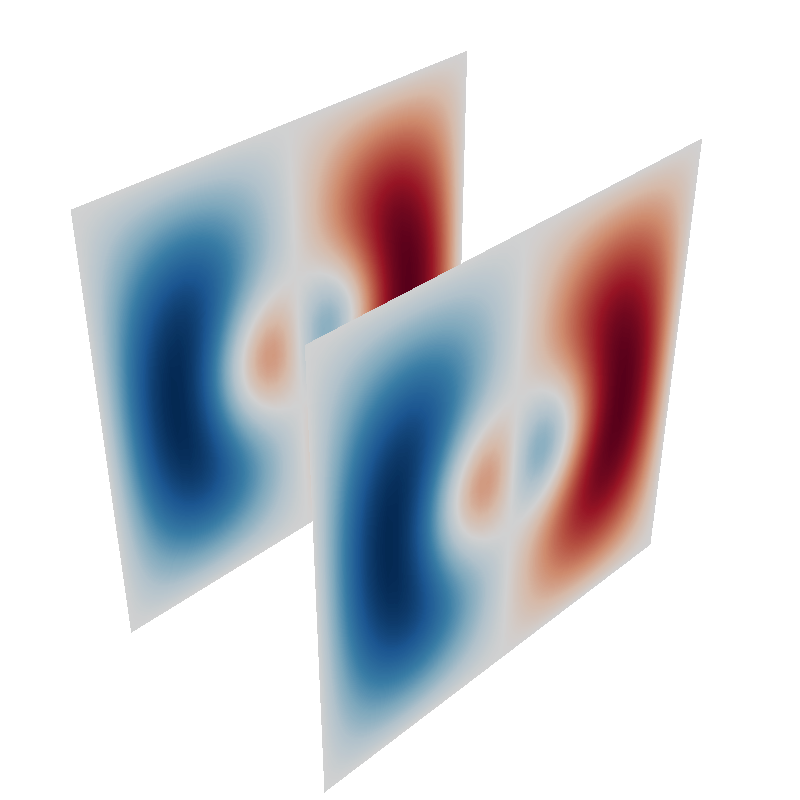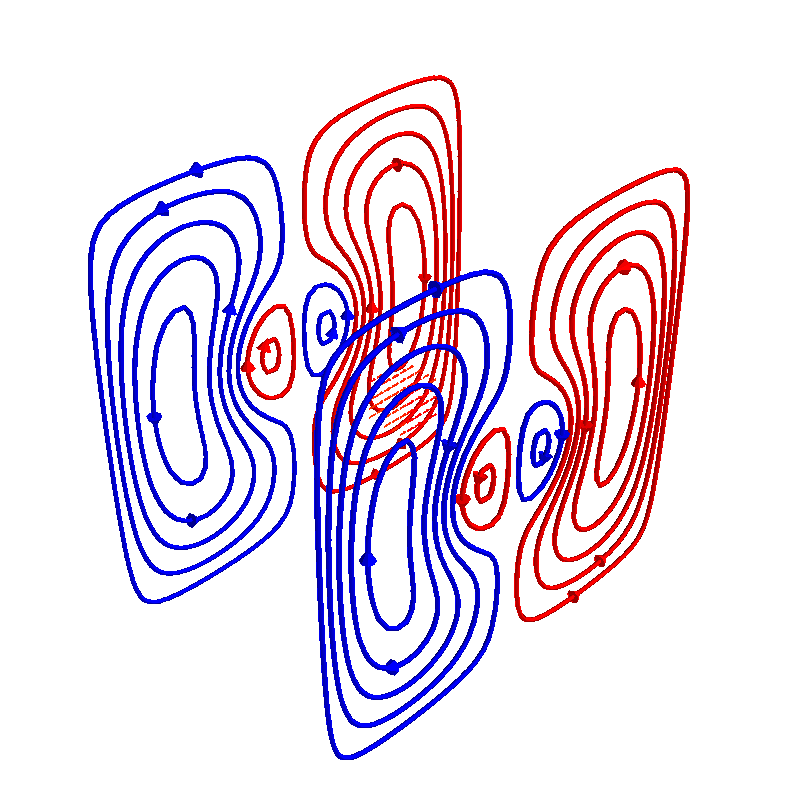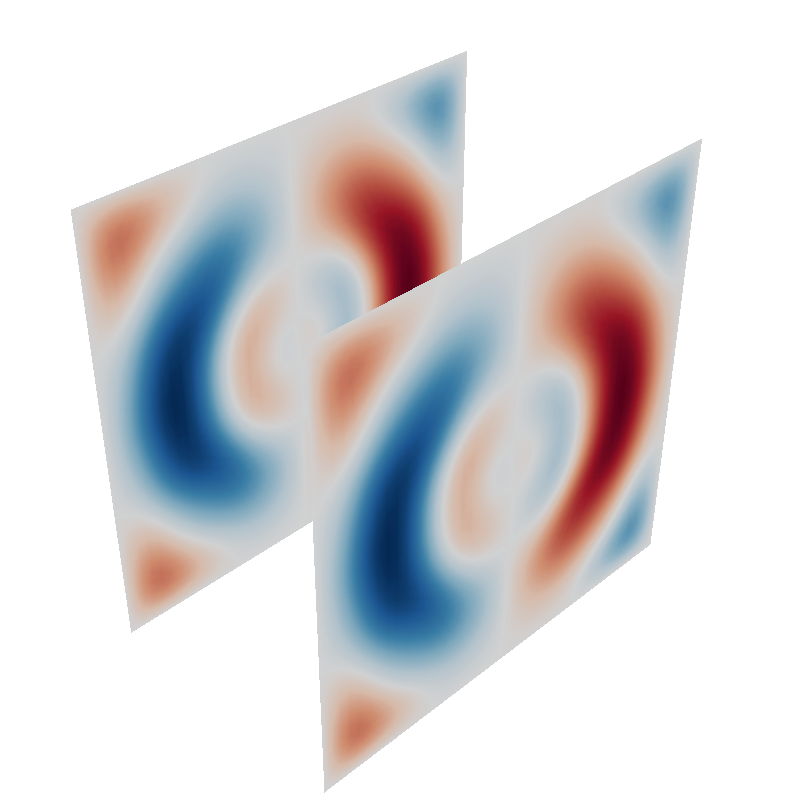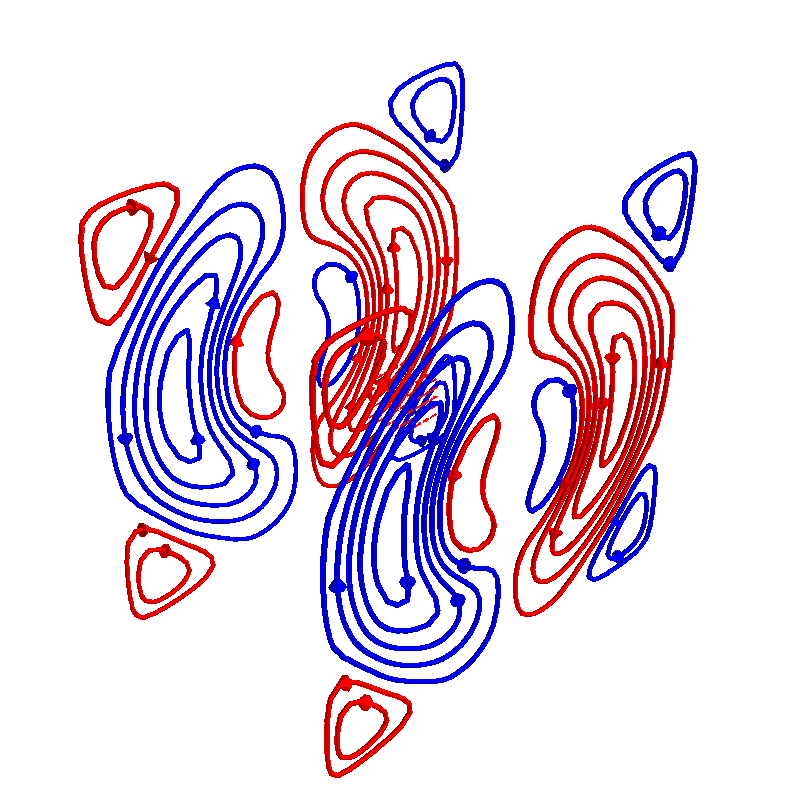Note
Click here to download the full example code
Biplanar coil design¶
Example showing a basic biplanar coil producing homogeneous field in a target region between the two coil planes.
import numpy as np
import matplotlib.pyplot as plt
from mayavi import mlab
import trimesh
from bfieldtools.mesh_conductor import MeshConductor
from bfieldtools.coil_optimize import optimize_streamfunctions
from bfieldtools.viz import plot_cross_section
from bfieldtools.utils import combine_meshes, load_example_mesh
# Load simple plane mesh that is centered on the origin
planemesh = load_example_mesh("10x10_plane_hires")
# Specify coil plane geometry
center_offset = np.array([0, 0, 0])
standoff = np.array([0, 3, 0])
# Create coil plane pairs
coil_plus = trimesh.Trimesh(
planemesh.vertices + center_offset + standoff, planemesh.faces, process=False
)
coil_minus = trimesh.Trimesh(
planemesh.vertices + center_offset - standoff, planemesh.faces, process=False
)
joined_planes = combine_meshes((coil_plus, coil_minus))
# Create mesh class object
coil = MeshConductor(
mesh_obj=joined_planes, fix_normals=True, basis_name="suh", N_suh=100
)
Out:
Calculating surface harmonics expansion...
Computing the laplacian matrix...
Computing the mass matrix...
Set up target and stray field points
# Here, the target points are on a volumetric grid within a sphere
center = np.array([0, 0, 0])
sidelength = 1.5
n = 8
xx = np.linspace(-sidelength / 2, sidelength / 2, n)
yy = np.linspace(-sidelength / 2, sidelength / 2, n)
zz = np.linspace(-sidelength / 2, sidelength / 2, n)
X, Y, Z = np.meshgrid(xx, yy, zz, indexing="ij")
x = X.ravel()
y = Y.ravel()
z = Z.ravel()
target_points = np.array([x, y, z]).T
# Turn cube into sphere by rejecting points "in the corners"
target_points = (
target_points[np.linalg.norm(target_points, axis=1) < sidelength / 2] + center
)
# Here, the stray field points are on a spherical surface
stray_radius = 20
stray_points_mesh = trimesh.creation.icosphere(subdivisions=3, radius=stray_radius)
stray_points = stray_points_mesh.vertices + center
n_stray_points = len(stray_points)
Create bfield specifications used when optimizing the coil geometry
# The absolute target field amplitude is not of importance,
# and it is scaled to match the C matrix in the optimization function
target_field = np.zeros(target_points.shape)
target_field[:, 0] += 1
target_spec = {
"coupling": coil.B_coupling(target_points),
"abs_error": 0.01,
"target": target_field,
}
stray_spec = {
"coupling": coil.B_coupling(stray_points),
"abs_error": 0.01,
"target": np.zeros((n_stray_points, 3)),
}
bfield_specification = [target_spec, stray_spec]
Out:
Computing magnetic field coupling matrix, 3184 vertices by 160 target points... took 0.29 seconds.
Computing magnetic field coupling matrix, 3184 vertices by 642 target points... took 0.59 seconds.
# Compute the optimal stream function, either using a numerical solver or regularized least squares
import mosek
coil.s, prob = optimize_streamfunctions(
coil,
[target_spec, stray_spec],
objective="minimum_ohmic_power",
solver="MOSEK",
solver_opts={"mosek_params": {mosek.iparam.num_threads: 8}},
)
Out:
Computing the resistance matrix...
Pre-existing problem not passed, creating...
Passing parameters to problem...
Passing problem to solver...
Problem
Name :
Objective sense : min
Type : CONIC (conic optimization problem)
Constraints : 4914
Cones : 1
Scalar variables : 203
Matrix variables : 0
Integer variables : 0
Optimizer started.
Problem
Name :
Objective sense : min
Type : CONIC (conic optimization problem)
Constraints : 4914
Cones : 1
Scalar variables : 203
Matrix variables : 0
Integer variables : 0
Optimizer - threads : 8
Optimizer - solved problem : the dual
Optimizer - Constraints : 101
Optimizer - Cones : 1
Optimizer - Scalar variables : 2728 conic : 102
Optimizer - Semi-definite variables: 0 scalarized : 0
Factor - setup time : 0.01 dense det. time : 0.00
Factor - ML order time : 0.00 GP order time : 0.00
Factor - nonzeros before factor : 5151 after factor : 5151
Factor - dense dim. : 0 flops : 1.80e+07
ITE PFEAS DFEAS GFEAS PRSTATUS POBJ DOBJ MU TIME
0 6.6e+02 1.0e+00 2.0e+00 0.00e+00 0.000000000e+00 -1.000000000e+00 1.0e+00 0.09
1 4.4e+02 6.6e-01 1.6e+00 -9.87e-01 1.242404686e-01 -3.791408582e-01 6.6e-01 0.10
2 1.2e+02 1.8e-01 7.8e-01 -9.60e-01 1.109693224e+00 3.956499435e+00 1.8e-01 0.11
3 1.6e+01 2.5e-02 1.8e-01 -7.07e-01 2.865215552e+01 4.020725058e+01 2.5e-02 0.12
4 7.0e-01 1.1e-03 3.6e-03 2.13e-01 3.463100175e+01 3.738850118e+01 1.1e-03 0.12
5 5.4e-01 8.2e-04 2.3e-03 1.20e+00 2.186623490e+01 2.373566156e+01 8.2e-04 0.13
6 4.7e-01 7.1e-04 1.8e-03 1.16e+00 2.672175433e+01 2.827057607e+01 7.1e-04 0.13
7 3.5e-01 5.3e-04 1.1e-03 1.13e+00 1.305976521e+01 1.412810407e+01 5.3e-04 0.14
8 6.6e-02 1.0e-04 7.6e-05 1.09e+00 1.135207342e+01 1.148805971e+01 1.0e-04 0.14
9 4.3e-03 6.5e-06 7.8e-07 1.02e+00 8.889593586e+00 8.892801886e+00 6.5e-06 0.15
10 1.4e-03 2.2e-06 1.5e-07 1.00e+00 8.380254067e+00 8.381363950e+00 2.2e-06 0.16
11 1.1e-04 1.6e-07 3.2e-09 1.00e+00 8.297805381e+00 8.297892684e+00 1.6e-07 0.16
12 4.1e-06 6.2e-09 2.4e-11 1.00e+00 8.294700570e+00 8.294703920e+00 6.2e-09 0.17
13 2.0e-07 3.0e-10 2.5e-13 1.00e+00 8.294657265e+00 8.294657426e+00 3.0e-10 0.18
14 3.0e-09 4.5e-12 1.2e-15 1.00e+00 8.294654536e+00 8.294654538e+00 4.5e-12 0.19
Optimizer terminated. Time: 0.19
Interior-point solution summary
Problem status : PRIMAL_AND_DUAL_FEASIBLE
Solution status : OPTIMAL
Primal. obj: 8.2946545357e+00 nrm: 2e+01 Viol. con: 1e-10 var: 0e+00 cones: 0e+00
Dual. obj: 8.2946545378e+00 nrm: 4e+01 Viol. con: 7e-06 var: 2e-11 cones: 0e+00
Plot the optimized stream function, then discretize it and plot coil windings and the resultant magnetic field
coil.s.plot()
loops = coil.s.discretize(N_contours=10)
loops.plot_loops()
B_target = loops.magnetic_field(target_points)
mlab.quiver3d(*target_points.T, *B_target.T)
Out:
<mayavi.modules.vectors.Vectors object at 0x7f0c5979a470>
Lets also do the same coil optimization using regularized least-squares. Now we can’t specify inequality constraints (e.g. use error margins in the specification).
from bfieldtools.coil_optimize import optimize_lsq
coil.s2 = optimize_lsq(
coil, [target_spec, stray_spec], objective="minimum_ohmic_power", reg=1e6
)
Out:
Error tolerances in specification will be ignored when using lsq
Plot the optimized stream function, then discretize it and plot coil windings and the resultant magnetic field
coil.s2.plot()
loops2 = coil.s2.discretize(N_contours=10)
loops2.plot_loops()
B_target = loops2.magnetic_field(target_points)
mlab.quiver3d(*target_points.T, *B_target.T)
Out:
<mayavi.modules.vectors.Vectors object at 0x7f0c5926ae30>
Plot cross-section of magnetic field and magnetic potential of the discretized loops
x = y = np.linspace(-12, 12, 250)
X, Y = np.meshgrid(x, y, indexing="ij")
points = np.zeros((X.flatten().shape[0], 3))
points[:, 0] = X.flatten()
points[:, 1] = Y.flatten()
B = loops2.magnetic_field(points)
U = loops2.scalar_potential(points)
U = U.reshape(x.shape[0], y.shape[0])
B = B.T[:2].reshape(2, x.shape[0], y.shape[0])
lw = np.sqrt(B[0] ** 2 + B[1] ** 2)
lw = 2 * lw / np.max(lw)
plot_cross_section(X, Y, U, log=False, contours=False)
seed_points = points[:, :2] * 0.3
plt.streamplot(
x,
y,
B[0],
B[1],
density=2,
linewidth=lw,
color="k",
integration_direction="both",
start_points=seed_points,
)
plt.axis("equal")
plt.axis("off")
plt.plot([-5, 5], [-3, -3], "k", linewidth=3, alpha=1)
plt.plot([-5, 5], [3, 3], "k", linewidth=3, alpha=1)
plt.tight_layout()
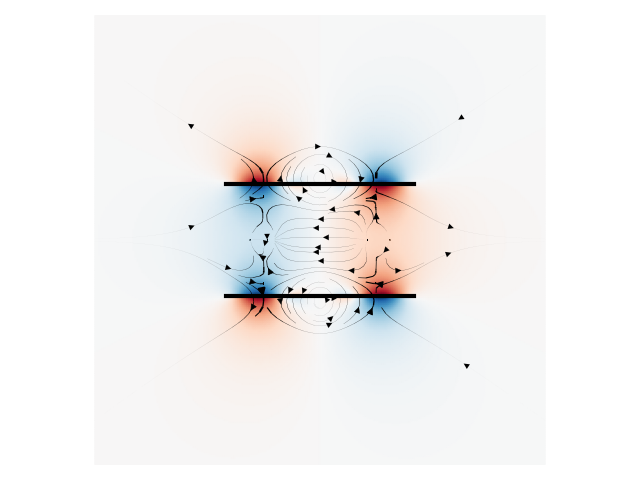
Total running time of the script: ( 1 minutes 20.879 seconds)
Estimated memory usage: 1494 MB

